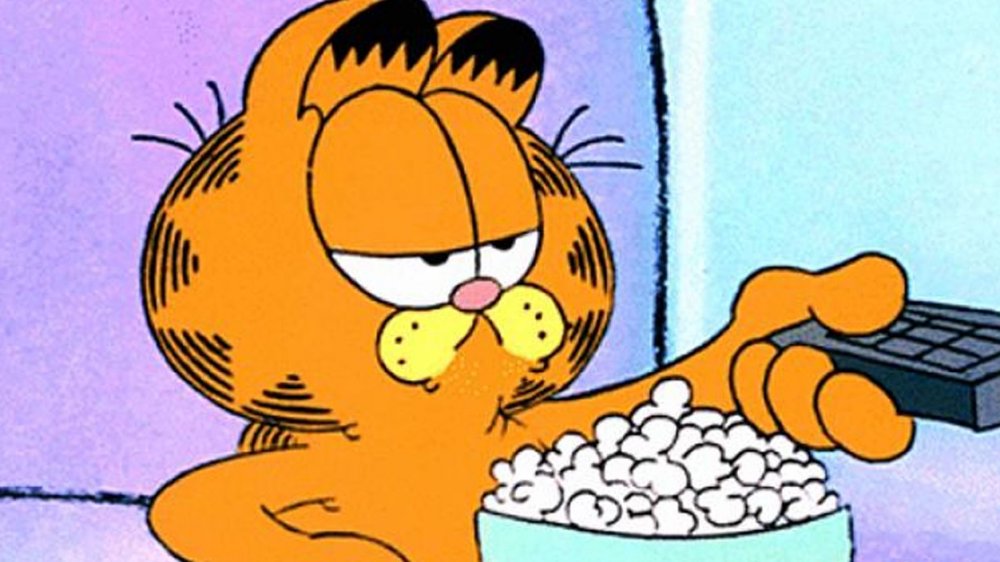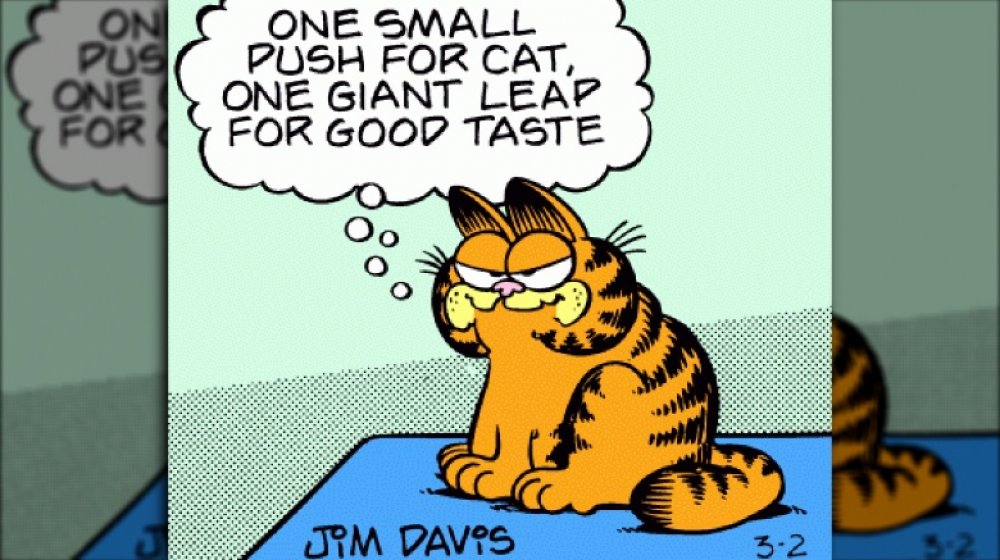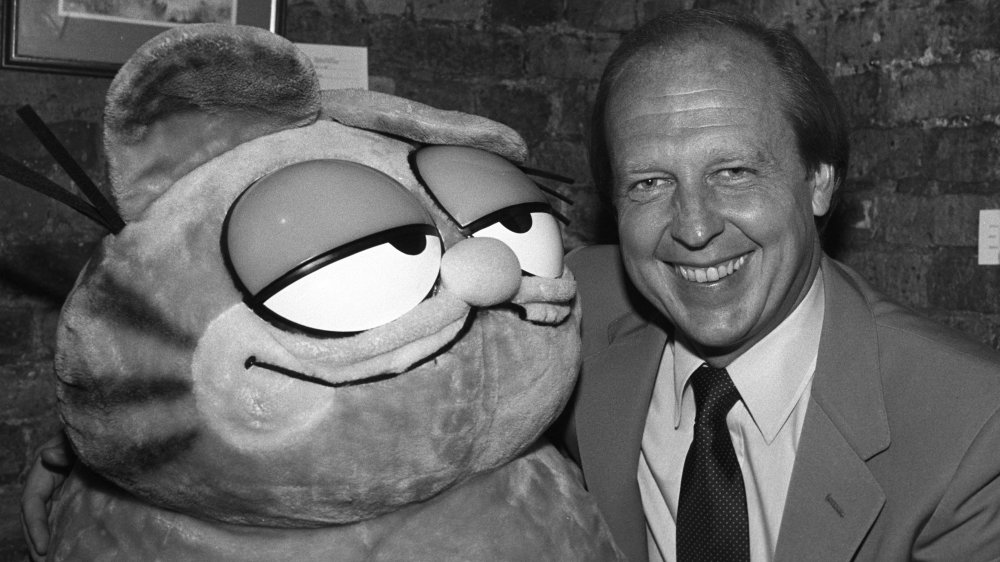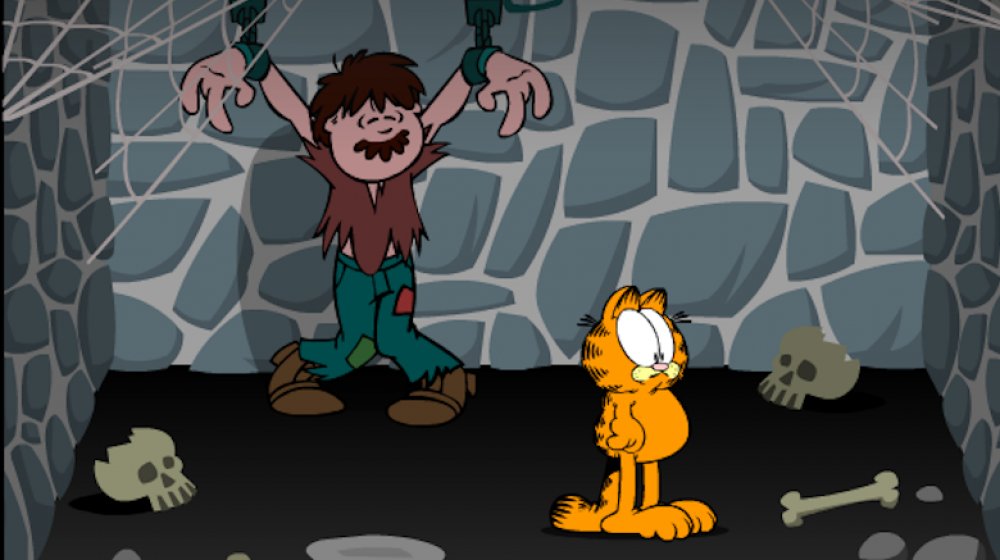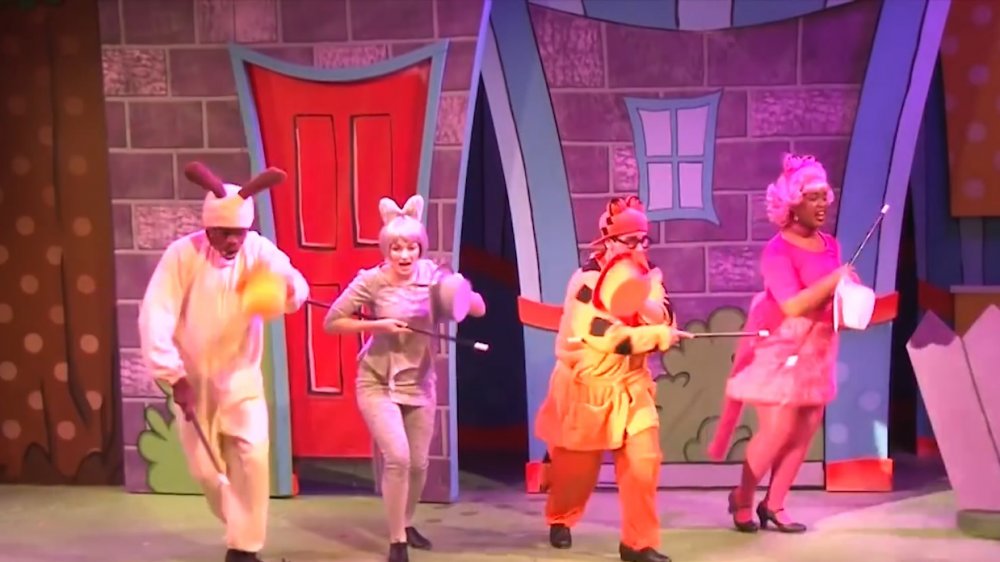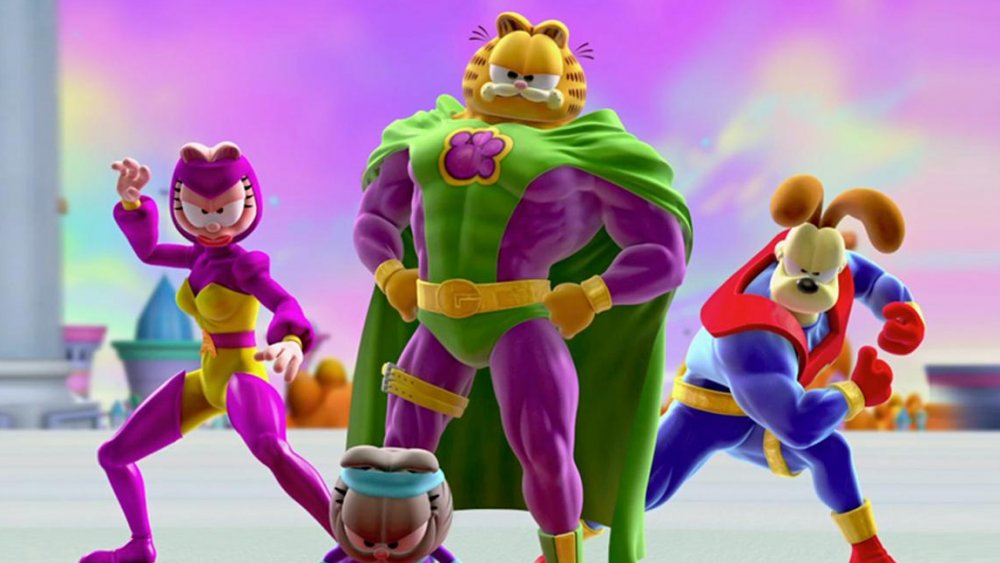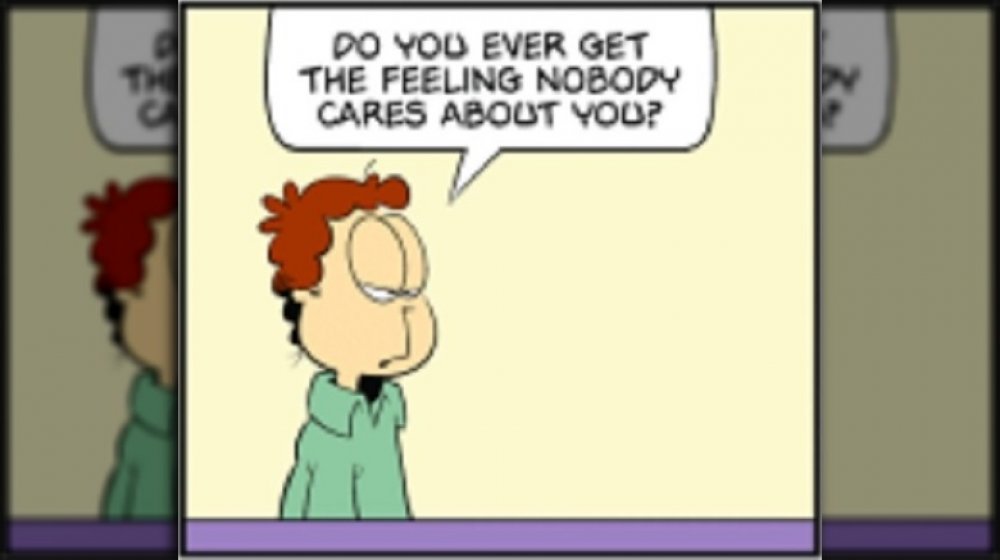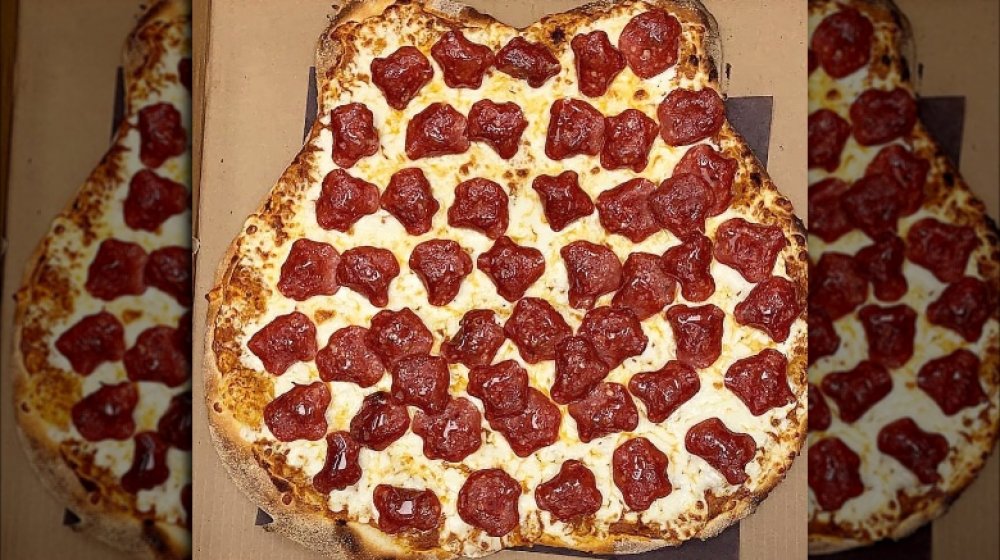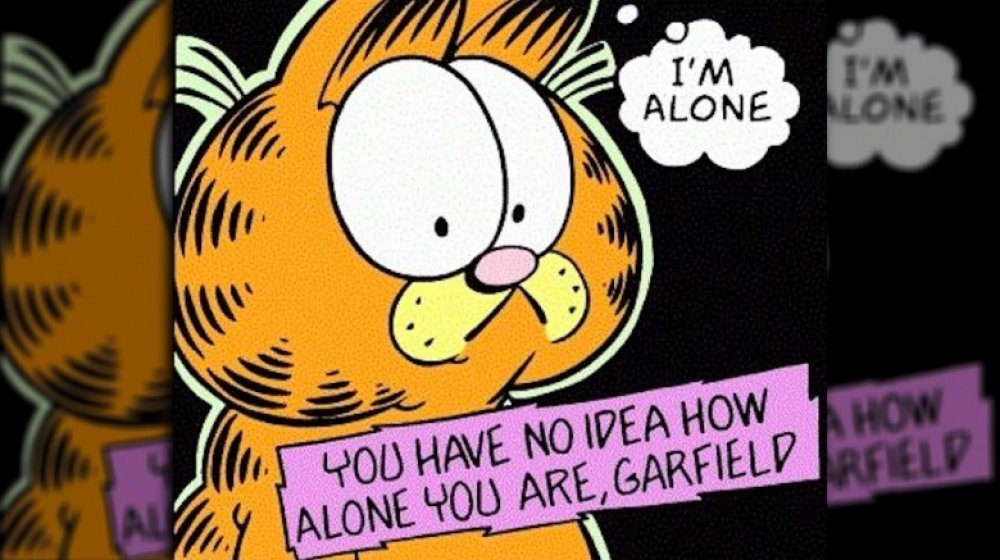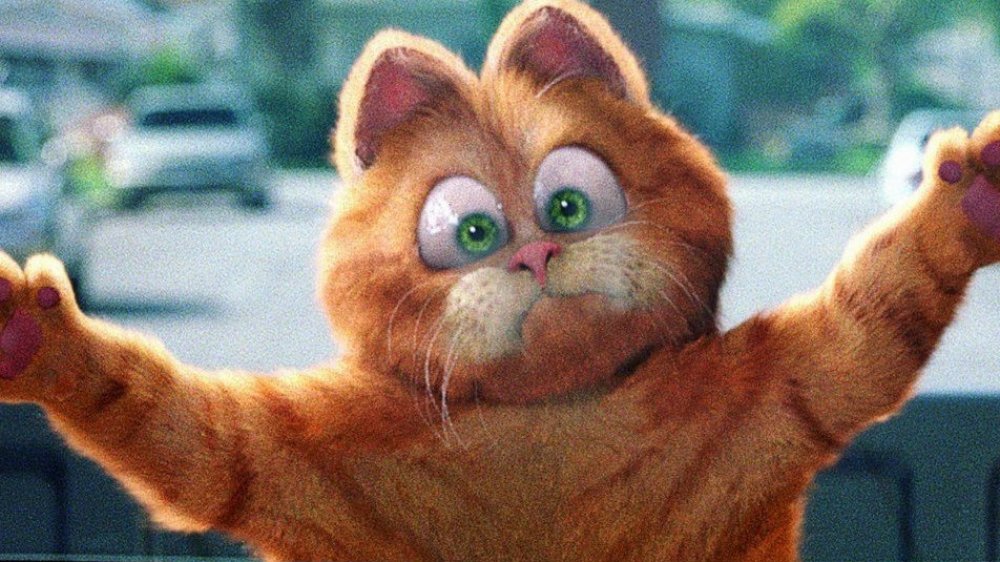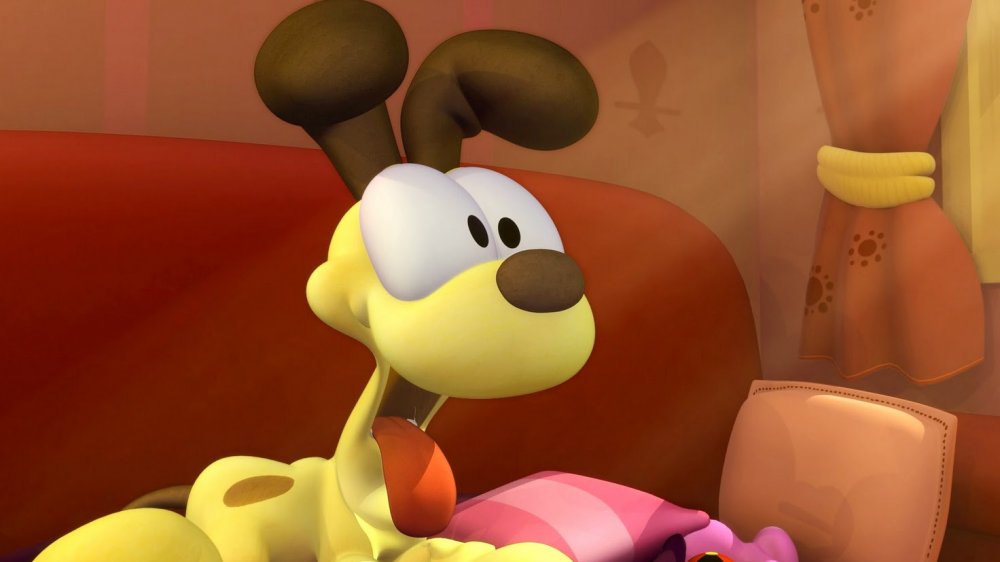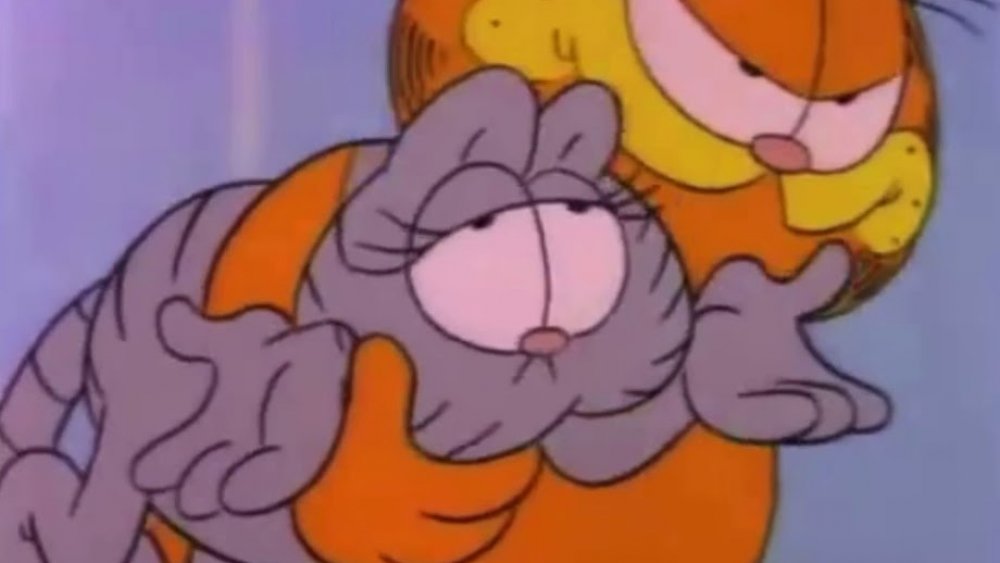The Bizarre History Of Garfield
It seems like Garfield has been around forever, but really, it's only been about 40 years. Debuting as a comic strip character in the late '70s, the sarcastic, lasagna-loving, Monday-hating, Odie-hurting orange cat sauntered into hearts and minds around the world thanks to a successful string of primetime TV specials and an animated series (voiced by Lorenzo Music), as well as some live-action movies (voiced by Bill Murray), not to mention countless pieces of merchandise. In the '80s, it seemed like everybody had a Garfield "I hate Mondays" T-shirt or a stuffed toy Garfield stuck to the window of their car with suction cups.
Garfield is a cultural institution at this point, enjoying a level of fame for a comic strip character previously bestowed only on the likes of Charlie Brown or Snoopy. He's been part of the world for so long, and in such a steady, easily understandable form, that he even gets under people's skin. But despite the fact he's a major pop culture icon, there's a lot of weirdness surrounding Garfield, in how he was conceived, how he's consumed, and even how he was created. Here's the very odd story and legacy of Garfield.
Jim Davis has done a lot more than just Garfield
Garfield isn't nearly the only comic strip created by Jim Davis. In 1986, the cartoonist started the farm animal strip U.S. Acres, and while it was never terribly popular and only ran for three years, it served as the "and Friends" part of TV's Garfield and Friends. And in the early '70s, before Garfield, Jim Davis broke out with a daily strip about a gnat and his insect friends called Gnorm Gnat. Gnorm had a wildly active inner life and lived alongside a sad fly, a dumb slug, a smart worm, and a spider-eating spider. But Davis managed to get the strip into just one newspaper, The Pendleton Times, based in his home state of Indiana. No other publication would touch it.
Davis told The Guardian that a newspaper syndicate editor once told him that while his strip was funny, "nobody can relate to bugs." So, he set out to make a strip featuring an animal that people would like ... and which could generate a merchandising empire, much like the way comic dog Snoopy did. "I took a long hard look at the comics. I saw dogs doing well. But no cats. I thought, 'Huh!'" And so, Davis decided to make a strip about cats, and he would draw on his experience growing up on a farm that was home to dozens of them.
Jon is Jim Davis, and Jim Davis is Jon
Jim Davis knew he wanted to feature a cat in his comic strip, and his first attempt, in 1976, was the semi-autobiographical Jon. Like Gnorm Gnat, it ran only in The Pendleton Times. Unlike Gnorm Gnat, it was about a grouchy cat named after and modeled on Davis' grandfather, James Garfield, who Davis told The Guardian was "a rather stern and intimidating person, but he had these really kind eyes — he was a teddy bear." But the cat was just a side character, and most of the action was about the main human figure, Jon, whom Davis based on himself. (There was also a proto-Odie named Spot.)
Davis eventually changed the name of the strip to Garfield, but it still wasn't the Garfield as the world knows it today. While Davis would continue to alter Garfield and Odie's looks later on, the titular cat earned a lot of his personality through an assist. Davis, while working in the studio of Peanuts TV special animator Bill Melendez, showed his drawings to Peanuts creator Charles Schulz one day. Davis couldn't figure out how to draw Garfield standing up and asked Schulz for help. "He took my drawing, and said, 'Here's your problem, he has these little cat feet. Give him big human feet," Davis told The Telegraph. "So Charles Schulz drew the first standing Garfield." The strip went nationwide in 1978.
The mystery of the missing roommate
Garfield has long featured the homebound adventures of just three characters — odd cartoonist Jon Arbuckle, hostile cat Garfield, and sweet dog Odie. However, in the early days of the strip, in the late '70s and early '80s, there was a fourth main character. His name was Lyman, and in the backstory of the comic, he was Jon's human roommate and the guy who brought Odie into the living situation. As Davis drew the strip and the characters' different dynamics developed, he realized that Jon no longer needed a human to talk to, since Garfield had become his sounding board, with the cat responding in thought balloons. So, one day in 1983, Lyman was in the Garfield strip, and the next day, he just wasn't.
According to Neatorama, Lyman was never spoken of for years and seen only a couple of times, once in a flashback and again as part of a title panel in a tenth anniversary strip. Hardcore Garfield fans always wondered just what happened to Lyman, and creator Jim Davis joked in a 1988 Garfield collection (via Bored Panda), "Don't look in Jon's basement." That quip was later referenced in the Garfield computer game Garfield's Spooky Scavenger Hunt, depicting Lyman shackled in a dungeon." In a 2014 Garfield comic book, however, Lyman is alive and well, and we learn that he went off to work as a wildlife photographer.
Garfield: The Musical is a real thing
Garfield long ago jumped off of the funny pages to conquer most all media. There have been animated TV specials, the Saturday morning cartoon Garfield and Friends, the CGI Garfield Show, two mostly live-action movies, comic books, and video games.
And believe it or not, there's even a theatrical musical.
Garfield creator Jim Davis had long dreamed of the project. "It was on my bucket list," he told The Washington Post, and at one point, he'd written the script for a potential Broadway production. But financiers didn't come through with the money, so Davis agreed to work on a whole new musical with the Adventure Theatre MTC in suburban Washington, D.C., which once made an original musical based on the comic strip Big Nate. And so, Garfield: The Musical With Cattitude (yes, that's its full, proper, and actual name) premiered in June 2015 and ran through the summer.
As for the plot, it's Garfield's birthday, and he expects a big celebration, but nothing much happens. Even worse, it falls on a Monday, Garfield's least favorite day of the week. Miffed, he runs away from home and has an adventure before realizing he had it pretty good at home with Jon and Odie. Oh, and it's performed by adult actors in animal suits, such as star Evan Casey who wore a modified orange sweatsuit — enhanced with black stripes, big pointy ears, and a pot belly — to play Garfield. Since then, the musical has been performed multiple times over the years with different actors, even making its way to Portugal.
Garfield's bizarre alter ego
Even Garfield himself would admit to some characteristics, if not flaws, about himself. He's lazy, and he only cares if his immediate needs and wants are met. That's pretty much the opposite of a superhero, who springs into action the moment their help is needed by anyone, even a stranger. This makes Garfield's Pet Force a particularly confusing part of the Garfield mythos.
First appearing as a series of kid novels in the late '90s, Pet Force takes place in a parallel universe, where a team of five superheroes (the Pet Force) serves Emperor Jon of Polyester, a planet constantly under attack by the villainous Vetvix (Dr. Liz, Garfield's veterinarian). Leading the Pet Force is Garzooka (superhero Garfield), who can shoot radiated hairballs, and he's assisted by Odious (Odie), Abnermal (Nermal), Starlena (Garfield's girlfriend, Arlene), and the robotic Compooky (Garfield's teddy bear, Pooky). Pet Force turned into a franchise-inside-of-a-franchise, spawning comic books, a video game, and even a theatrically released film.
What did the internet do to you, Garfield?
Garfield in its many forms — comic strip, anthologies, TV specials, a TV series — existed in various iterations for decades before the internet took off. A couple of generations of artists and comedians grew up consuming Garfield and absorbing its tropes, and when they came of age, they analyzed, deconstructed, and re-presented the comic strip in whole new — and astoundingly skewed — ways. As a result, weird Garfield stuff has become its own hilarious, baffling, and unsettling corner of the internet.
For example, there's "Garfield Minus Garfield," which takes real strips from the Garfield archives, only without Garfield. The result is Jon talking to himself — as there's nobody there to listen or comment — and he seems to have gone mad. Or take "Realfield," in which an artist has subbed out Garfield with a realistic looking and behaving cat, which serves to make Jon look like an extremely lonely man. "Barfield" is a parody by "Dim Javis" where Garfield can't stop vomiting. Also, rendering Garfield as grotesque, dark, and monstrous as possible has grown into an art movement of sorts, nicknamed "I'm Sorry, Jon," because the cartoons usually involve Garfield killing Jon. Perhaps the oddest of all is "Lasagna Cat," a site full of short video re-creations (and bizarre variations) of real Garfield strips by actors in Garfield, Odie, and Jon costumes.
Care for a Garfuccino?
One of the running jokes of Garfield, or at least it's a characteristic of the comic strip feline, is that he loves food. While he has expressed on numerous occasions that his favorite food is lasagna — and he'll scarf down an entire gigantic pan of the stuff in about five seconds if given the chance — he's really an indiscriminate eater, more glutton than gourmet. Garfield's relationship with food isn't the healthiest or all that complex, and yet fans of the franchise can dine at GarfieldEats, a Garfield-themed Italian fast food joints in Toronto.
According to Food & Wine, it operates out of a storefront covered with a giant image of Garfield pointing to a man in a suit, with a thought bubble that reads, "This is the man who made a pizza out of my face. That's nice, but I'd prefer it in my mouth." That man is Nathen Mazri, who licensed Garfield's image to open an app-based, delivery and takeout only restaurant that serves, yes, pizzas shaped like Garfield's head and also lasagna, French fries, the "Farm Salad" (Jon Arbuckle grew up on a farm), and chocolate coffee drinks called Garfuccinos. While customers wait to take home their food, they can watch old episodes of Garfield and Friends on monitors.
Have Garfield and Jon been dead for 30 years?
In the fall of 1989, Jim Davis dropped the usual Garfield routines of Garfield wanting food, rolling his eyes at Jon, and tormenting Odie. He went extremely dark. According to an email interview with Boing Boing, Davis wanted to run a series of strips around Halloween that were appropriately scary but not centered around ghosts or other spooky creatures. Rather, he wanted to reflect on what truly terrifies people, and after asking family and friends what actually scared them, he went with the most common answers of "alone" and "dying alone." And so, Davis created a serialized collection of Garfield strips in which the cat finds himself all alone, with no food, in a decrepit, decaying mansion. Garfield grows increasingly panicked and desperate, and the comic includes a narration bubble that reads, "Locked fast within a time when he no longer exists, Garfield grapples with his greatest fear ... loneliness."
As the strips were later rediscovered on the internet, it led to a dark fan theory ... that these cartoons depicted Garfield's actual death, and that he'd died long ago, and all subsequent strips contained non-events. When asked point blank if this was true, Davis laughed and assured fans that Garfield wasn't dead nor starving to death. The strips in question were just a non-canonical Halloween experiment, not unlike the "Treehouse of Horror" episodes of The Simpsons.
The mistake that led to Bill Murray voicing Garfield
Long a beloved comedy icon because of Caddyshack, Ghostbusters, and Groundhog Day, Bill Murray went the vulnerable, dramatic route as listless actor Bob Harris in Sofia Coppola's Lost in Translation and secured his first ever Academy Award nomination. Murray's first major film after his reinvention? Garfield: The Movie. He voiced the famous cat, rendered in CGI against a live-acting cast and setting. The movie was a run-of-the-mill kiddie flick that critics loathed (it's got a 15 percent on Rotten Tomatoes), with many left baffled as to why Murray would risk his newfound credibility.
"I thought it would be kind of fun, because doing a voice is challenging, and I'd never done that," Murray told GQ in 2010. "Plus, I looked at the script, and it said, 'So-and-so and Joel Coen.'" At least Murray thought the screenplay was credited to Joel Coen, one of Academy Award-winning Coen Brothers. However, the actual scriptwriter was Joel Cohen, who'd previously penned Cheaper by the Dozen, Monster Mash: The Movie, and had helped out on Toy Story.
The story has another odd quirk. As the voice of Garfield, Murray replaced Lorenzo Music, who played the character in TV projects up until his death in 2001. One of Music's other prominent roles was the part Peter Venkman on the TV cartoon The Real Ghostbusters ... the character played by Murray in the Ghostbusters films.
Dumb dog Odie is based on a real 'idiot'
After Garfield and Jon Arbuckle, the third most prominent character in Garfield is Odie, a forever friendly and perky dog, despite Garfield's violent animosity for him. He debuted early on in the strip's run, popping up in 1978 as the pet of Jon's roommate, Lyman, and remaining even after his master disappeared. Other than his unbreakably good mood, Odie's main characteristic is that he's incredibly dumb. How dumb is he? According to the Garfield official website, Odie didn't know how to breathe until he was three years old, and "his IQ is so low you have to dig for it."
Possibly the dumbest thing about Odie is his name. What's an Odie, anyway? Has anyone ever seen or heard of anything named an Odie before (or after) Garfield? Well, creator Jim Davis took it from an old project he worked on before his professional cartooning days. "I wrote a commercial for a local car dealership featuring Odie, the village idiot," Davis said. "I liked the name, so I used it again."
Garfield's very 'stupid' mistake
By and large, comic strips are just about the most innocuous, family-friendly form of mass media out there, and Garfield is among the more innocent, what with its stories about lasagna-eating cats and dumb dogs. And yet the strip's creator, Jim Davis, once had to publicly apologize after the strip inadvertently offended a sizable segment of the population.
A November 2010 strip depicted the thoughts of a spider, just before Garfield was about to whack it to death with a rolled newspaper. "If you squish me, I shall become famous!" the spider says in the first panel. "They will hold an annual day of remembrance in my honor," he continues. The third and final panel cuts to a spider classroom, where a spider teacher says to an audience of young spiders, "Does anyone here know why we celebrate 'National Stupid Day'?" In other words, the spider martyred himself at Garfield's hand, and the spider world remembers him because he's stupid. Unfortunately, this commemoration of "National Stupid Day" happened to run on Veterans Day.
Calling the incident "the worst timing ever," Davis issued an apology. "The strip that runs in today's paper seems to be making a statement about Veterans Day. It absolutely, positively has nothing to do with this important day of remembrance."
The truth about Nermal
Nermal is an occasional guest star in Garfield comics and TV projects, but even just once in a while is way too much for Garfield. The older cat absolutely loathes his younger counterpart, seemingly on account of how Nermal is very cute and seems to know it. But while Nermal can be a bit obnoxious, that's not what's created created debate among Garfield fanatics. Instead, according to the Garfield official website, people just aren't sure if Nermal is male, female, or perhaps identities otherwise. It might be because Nermal has enviably long and luxurious eyelashes, often a physical trait associated with women. And then on the Garfield and Friends TV series, producers cast female voice actor Desirée Goyette to play the cat. In the Latin American adaptation of the show, Nermal's name was changed to Telma, a female name. Nevertheless, Jim Davis has confirmed that Nermal is a boy cat.
